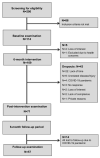Very Low-Volume, High-Intensity Interval Training Mitigates Negative Health Impacts of COVID-19 Pandemic-Induced Physical Inactivity
- PMID: 36231609
- PMCID: PMC9565952
- DOI: 10.3390/ijerph191912308
Very Low-Volume, High-Intensity Interval Training Mitigates Negative Health Impacts of COVID-19 Pandemic-Induced Physical Inactivity
Abstract
Initially, we aimed to investigate the impact of a one-year worksite low-volume, high-intensity interval training (LOW-HIIT) on cardiometabolic health in 114 sedentary office workers. Due to the COVID-19 pandemic outbreak, LOW-HIIT was discontinued after 6 months and participants were followed up for 6 months to analyze physical activity/exercise behavior and outcome changes during lockdown. Health examinations, including cardiopulmonary exercise testing and the assessment of cardiometabolic markers were performed baseline (T-1), after 6 months (T-2, termination of worksite LOW-HIIT) and 12 months (T-3, follow-up). Cycle ergometer LOW-HIIT (5 × 1 min at 85-95% HRmax) was performed 2×/week. For follow-up analyses, participants were classified into three groups: HIIT-group (continued home-based LOW-HIIT), EX-group (continued other home-based exercises), and NO-EX-group (discontinued LOW-HIIT/exercise). At T-2, VO2max (+1.5 mL/kg/min, p = 0.002), mean arterial blood pressure (MAB, -4 mmHg, p < 0.001), HbA1c (-0.2%, p = 0.005) and self-reported quality of life (QoL, +5 points, p < 0.001) were improved. At T-3, HIIT-group maintained VO2max and QoL and further improved MAB. EX-group maintained MAB and QoL but experienced a VO2max decrease. In NON-EX, VO2max, MAB and QoL deteriorated. We conclude that LOW-HIIT can be considered a promising option to improve cardiometabolic health in real-life conditions and to mitigate physical inactivity-related negative health impacts during lockdowns.
Keywords: cardiometabolic health; exercise; health promotion; lockdown; occupational health management; physical activity.
Conflict of interest statement
The authors declare no conflict of interest.
Similar articles
-
Low-volume high-intensity interval training improves cardiometabolic health, work ability and well-being in severely obese individuals: a randomized-controlled trial sub-study.J Transl Med. 2020 Nov 7;18(1):419. doi: 10.1186/s12967-020-02592-6. J Transl Med. 2020. PMID: 33160382 Free PMC article. Clinical Trial.
-
Protein Supplementation Does Not Maximize Adaptations to Low-Volume High-Intensity Interval Training in Sedentary, Healthy Adults: A Placebo-Controlled Double-Blind Randomized Study.Nutrients. 2022 Sep 20;14(19):3883. doi: 10.3390/nu14193883. Nutrients. 2022. PMID: 36235536 Free PMC article. Clinical Trial.
-
Improved brachial artery shear patterns and increased flow-mediated dilatation after low-volume high-intensity interval training in type 2 diabetes.Exp Physiol. 2018 Sep;103(9):1264-1276. doi: 10.1113/EP087005. Epub 2018 Jul 22. Exp Physiol. 2018. PMID: 29932275
-
Is low-volume high-intensity interval training a time-efficient strategy to improve cardiometabolic health and body composition? A meta-analysis.Appl Physiol Nutr Metab. 2024 Mar 1;49(3):273-292. doi: 10.1139/apnm-2023-0329. Epub 2023 Nov 8. Appl Physiol Nutr Metab. 2024. PMID: 37939367 Review.
-
Effect of high-intensity interval training protocols on VO2max and HbA1c level in people with type 2 diabetes: A systematic review and meta-analysis.Ann Phys Rehabil Med. 2022 Sep;65(5):101586. doi: 10.1016/j.rehab.2021.101586. Epub 2021 Nov 19. Ann Phys Rehabil Med. 2022. PMID: 34648979
Cited by
-
Protein Supplementation Increases Adaptations to Low-Volume, Intra-Session Concurrent Training in Untrained Healthy Adults: A Double-Blind, Placebo-Controlled, Randomized Trial.Nutrients. 2024 Aug 15;16(16):2713. doi: 10.3390/nu16162713. Nutrients. 2024. PMID: 39203849 Free PMC article. Clinical Trial.
References
-
- Lear S.A., Hu W., Rangarajan S., Gasevic D., Leong D., Iqbal R., Casanova A., Swaminathan S., Anjana R.M., Kumar R., et al. The effect of physical activity on mortality and cardiovascular disease in 130,000 people from 17 high-income, middle-income, and low-income countries: The PURE study. Lancet. 2017;390:2643–2654. doi: 10.1016/S0140-6736(17)31634-3. - DOI - PubMed
-
- Lee I.M., Shiroma E.J., Lobelo F., Puska P., Blair S.N., Katzmarzyk P.T., Lancet Physical Activity Series Working Group Effect of physical inactivity on major non-communicable diseases worldwide: An analysis of burden of disease and life expectancy. Lancet. 2012;380:219–229. doi: 10.1016/S0140-6736(12)61031-9. - DOI - PMC - PubMed
-
- Wen C.P., Wai J.P.M., Tsai M.K., Yang Y.C., Cheng T.Y.D., Lee M.-C., Chan H.T., Tsao C.K., Tsai S.P., Wu X. Minimum amount of physical activity for reduced mortality and extended life expectancy: A prospective cohort study. Lancet. 2011;378:1244–1253. doi: 10.1016/S0140-6736(11)60749-6. - DOI - PubMed
-
- Myers J., McAuley P., Lavie C.J., Despres J.P., Arena R., Kokkinos P. Physical activity and cardiorespiratory fitness as major markers of cardiovascular risk: Their independent and interwoven importance to health status. Prog. Cardiovasc. Dis. 2015;57:306–314. doi: 10.1016/j.pcad.2014.09.011. - DOI - PubMed
Publication types
MeSH terms
LinkOut - more resources
Full Text Sources
Medical
Miscellaneous


